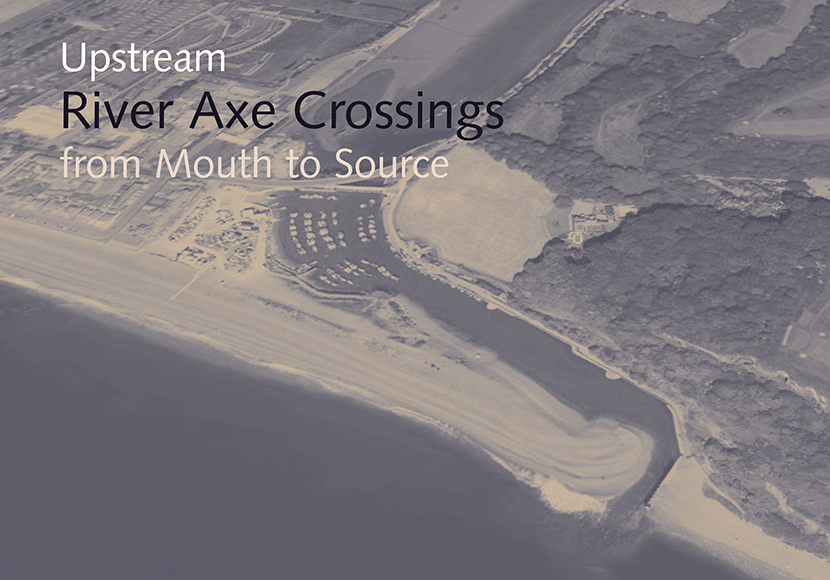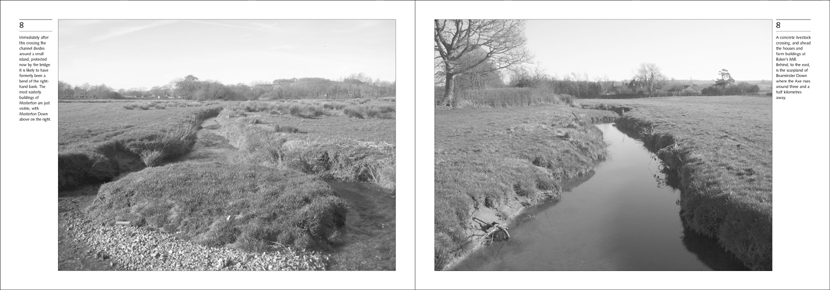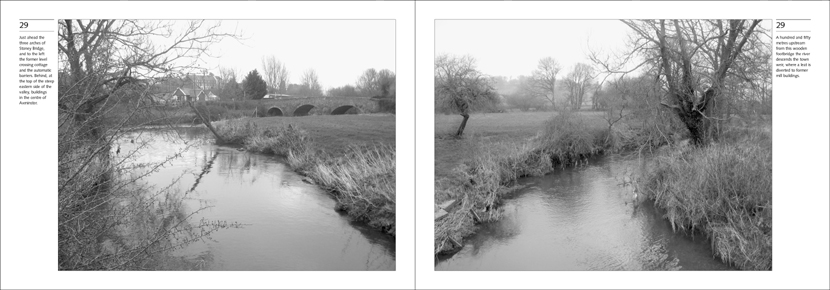River Axe Crossings
A visual survey along the course of the river
For more than one copy or to order multiple titles please email your order and we will calculate the postage cost.
Email Uniformbooks
ISBN 978 0 9537048 8 0
84 full-page half-tones and descriptive texts, introduction and diagrammatic aerial view.
96pp, 147 x 218, paperback
Colin Sackett, Axminster, 2008
Distributed by Uniformbooks
£7.95
Slideshows
From source to mouth
From mouth to source



The River Axe flows through Dorset, Somerset and Devon, rising near Beaminster, flowing west then south by Axminster and joining the English Channel at Axmouth near Seaton. During its thirty-five kilometre course it is fed by various streams and by the tributary rivers Yarty and Coly. Taken during the period November 2007 to March 2008, the photographs look directly upstream and downstream from the centre of each of all the forty-one extant crossings, ranging variously from plain wooden beam, to stone arch, to concrete road bridge; excluded are weirs, railway bridges, and crossings by ford or stepping stones.
From the front of the book the right-hand page sequence shows the direction from mouth to source,
while from the back the left-hand sequence is downstream with the river’s flow. The crossings are numbered
from source to mouth, and while the distances between vary, no account is made from one to the next other
than the immediate stage of the river beyond and the particular landscape pictured.
“The way into the Axe book is by way of what it is not. From the front of the book the right-hand page sequence follows the direction of the river from sea to source, from the back the left-hand sequence moves downstream with the river’s flow. This self-cancelling movement is cut across at forty-one points by bridges of different kinds.
Books have beginnings and ends, front and back covers, but the linear movement is replaced here by a transverse one, raising questions about where, when and why each of the crossings took place. The illustrations at the same time forgo the bridges themselves, picturesque or piquant as many of them are. This is not a sequence of calendar portraits: the crossings are present only as points of vantage, looking up or downstream. Physical appearances are underplayed in low-angled views in black and white under invariably low skies and foreshortened perspective. The contrast is reduced to shades of middle grey on unyielding shiny paper that throws the images onto the surface. Indeed, the proportion of pictorial denial accumulates to a point where one is forced to take stock and consider the purposed gain.
The book interrupts the conventional river story-line of rise, accumulation and outflow, refuses to be sidetracked by the celebratory spirit, and redirects attention onto the human imperatives that have intersected a natural conduit at different times and for different reasons. It offers neither comfort nor manifesto; it is about landscape, settlement and communication: necessary engagements with a natural feature that remains unchanged. It shows a way of looking at the Axe valley as it has evolved in collaboration with man: not so much nature writing as human geography. The comments are specific and informative, and again what is not said is as pertinent as the chosen words.”
J. C. C. Mays: ‘Rare Sighting in the Haldon Hills’ (2009)
“One of the most striking features of River Axe Crossings is the visual absence of the actual crossings. The perspective that Sackett has chosen places the photographer in the centre of each crossing, where he documents the doubled vantage this position offers upstream, downstream. The material substance of the structure that lies under the photographer’s feet is often recorded in meticulous field notes included at the margin of each page: ‘three-arched stone bridge’ (30, 20), ‘railed concrete foot bridge’ (21), ‘a livestock crossing of parallel railway sleepers’ (34). Sometimes you catch a glimpse of a far crossing in an upstream or downstream picture frame, if the crossings are particularly close together and the line of sight is clear. But, for the most part, the crossings function as standpoint rather than substance, a somewhat arbitrary link in the looping visual chain (upstream, downstream, upstream, downstream) created by the survey of the river’s course. There is a curious deferral at work here, which forces the reader/viewer’s attention to become aware of the simple oddity of standing above moving water, a still point in a liquid landscape.”
Caitlin DeSilvey: ‘River Axe Crossings’. Reviews, Journal of Historical Geography 36 (2010)
